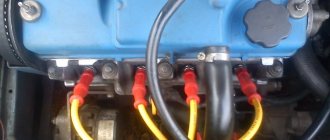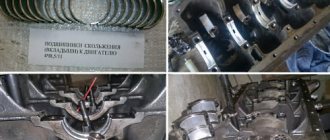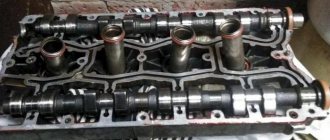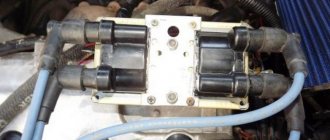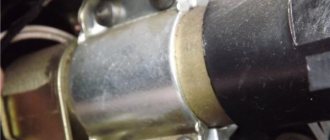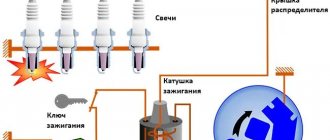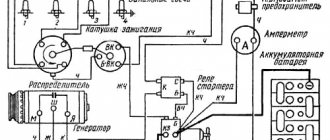02/28/2022 25,669 GAS
Author: Ivan Baranov
Every car enthusiast knows that the ignition system in any car is needed to ignite the combustible mixture in the engine. GAZ trucks are no exception. In this article, we propose to find out what the ignition procedure for the GAZ-53 is, what malfunctions a car enthusiast may encounter, and how it is configured.
[Hide]
Design of the GAZ-53 ignition system
In order to repair and configure the SZ on the GAZ-53, you need to know how it works.
These trucks are equipped with a contactless protection system, which consists of the following components:
- power source – battery;
- switch;
- wires;
- additional relay;
- coil;
- breaker-distributor;
- current indicator;
- resistor element;
- ignition switch (switch).
Knowing the structure of the protection system, the connection diagram of the protection device and its other components, as well as the functions that each element performs, you can identify problems based on their symptoms and eliminate their cause. All components of the system can be divided into groups according to the tasks performed.
For normal operation of the internal combustion engine, the following conditions must be met:
- powerful spark;
- correspondence between the formation of a spark and the operation of the power unit;
- no missed spark formation.
The entire electronic ignition system consists of two circuits: primary and secondary.
The primary includes the following elements:
- Battery with multi-core cables of large cross-section;
- a switch that supplies power to the circuit;
- primary winding;
- breaker distributor located in the distributor;
- switching device that ensures stable operation;
- the resistance necessary for successful starting of the engine and unloading the short circuit, preventing its overheating.
The secondary circuit includes:
- distributor;
- wires for supplying high voltage current;
- candles.
When the primary circuit receives power, a magnetic field is generated in the breaker. The rotation of the distributor interrupts the current in this place, which leads to the disappearance of the magnetic field. At this moment, a signal appears on the secondary winding, which goes to the cylinders.
Photo gallery
Successful sparking is ensured by stable operation of the motor and the appearance of sufficient voltage on the electrodes. The power of the spark is affected by the size of the gaps between the electrodes and the amount of incoming voltage.
With a weak spark or its absence, fuel consumption increases and engine power decreases.
Main elements of the system
To know how to properly adjust and configure the system, we recommend that you first familiarize yourself with the device. GAZ-53 trucks are equipped with contactless SZ.
Such a BSZ is battery-powered, since it contains current sources, in particular, we are talking about:
- battery;
- the coil itself;
- switching device;
- breaker-distributor;
- candles;
- resistor element;
- switch SZ.
Tuned truck GAZ-53
Any SZ of a GAZ truck includes two circuits: high and low voltage.
The main components of the low-voltage network are:
- 12 volt battery.
- Battery cables with terminals. These cables are multi-core and have a large cross-section.
- Directly the lock, which performs the function of supplying power to the circuit.
- The contactless circuit for GAZ is equipped with an ignition distributor breaker device mounted in the distributor. If the system is contact, then the function of this component is performed by the distributor pulley, as well as contacts. In addition, a Hall sensor is sometimes installed instead of a breaker.
- A switch designed to ensure stable operation of the power unit.
- Resistance designed to ensure normal engine starting and unload the work of the GAZ ignition coil when the power unit operates at high speeds. Thanks to this component, the coil cannot overheat.
- Primary winding.
As for the secondary section, it includes the following components:
- secondary winding;
- distribution element, which includes a pulley, a cover, and a runner;
- high-voltage wires transmitting a signal to the spark plugs;
- candles.
When the lock is activated, a magnetic field begins to form in the breaker design in the primary section. When the distributor shaft rotates, the current in this section of the circuit is interrupted, and accordingly, the formed field disappears. At this time, a signal begins to appear in the winding of the secondary circuit, which subsequently diverges through the cylinders.
Electrical circuit of the SZ vehicle GAZ-53
Possible malfunctions of the SZ: signs and causes
Malfunctions in the SZ affect the power of the power unit, it decreases, and economical fuel consumption.
The following reasons can be cited for the unstable operation of the SZ on the GAZ-53:
- Switch overheating or failure. When the switch overheats, the spark disappears and the engine will not start. It becomes possible to start the engine only after it has cooled down and a spark appears. The coil is also susceptible to overheating.
- Breakdown in high-voltage wires. This happens if the wire is not held tightly enough in the distributor cover: the motor will operate unstably and intermittently. The breakdown of the wires is noticeable in the dark - blue sparks jump.
- The cover on the breaker-distributor burned out. A malfunction can be detected by visual inspection. It is possible to burn in the place where the corner with the spring is installed. The cover must be free of defects and must not have potholes or cracks.
- The contacts of the distributor slider may burn out.
- Breakdown of candles.
If the diaphragm makes gaps on the vacuum regulator of the distributor, then a drop in engine power is observed. Moreover, if you accelerate sharply, the power unit will choke and may overheat. The distributor rarely fails; most often the cause of its failure is wear due to the exhausted resource.
Useful tips
The ignition system of the GAZ 53 vehicle requires periodic inspection. It is necessary to check the quality of fit of high-voltage wires into the sockets of the coil and distributor. If there is a weakening of the contact, then you need to unbend the wire connectors and insert them into the sockets until they stop. A breakdown of the ignition coil is most likely if it is covered with a layer of dust, dirt or in water. Therefore, this should be avoided if possible. Leaving the GAZ 53 with the ignition on and the engine not running can lead to a breakdown of the coil.
The fact is that there is always voltage in the primary winding when the ignition is on and the engine is not running, because the breaker sensor does not work. When purchasing new spark plugs, it is advisable to install those recommended by the manufacturer, having first checked the gap between the electrodes. Adjust it if necessary. Replacing elements with new ones with different markings may lead to failure of other components of the system. It is necessary to periodically lubricate the distributor shaft through the existing oiler.
Instructions for setting up the ignition
The cause of engine overheating and loss of power may be late ignition. This may manifest itself as popping noises in the intake manifold. Therefore, you need to know how to install the ignition correctly (the author of the video is Nail Poroshin).
Installation is carried out according to the marks as follows:
- First, you need to set the piston on the first cylinder to TDC and align the installation indicator mark with the mark on the crankshaft pulley.
- Next, the crankshaft must be turned counterclockwise until the marks 9 on the pointer coincide with the marks on its pulley.
- Then you need to loosen the bolt on the top plate of the corrector, thanks to which it is attached to the breaker.
- Next, you need to connect one control wire to the car body (ground) and the second to the breaker terminal. After turning on the ignition, the breaker should be turned slowly until the control lights up. This indicates that the contacts have begun to open.
- Now you need to tighten the breaker mounting bolt and install the cover and rotor. In the area opposite to the one where the rotor plate was installed, you need to connect the high-voltage wire to the spark plug on the 1st cylinder. The remaining wires are connected to the cylinder spark plugs, according to the order in which they work: 1-5-4-2-6-3-7-8.
It is necessary to set the ignition timing of the GAZ-53 accurately, since with deviations the engine power decreases and fuel consumption increases. In addition, burnout of valves, pistons, breakdowns in the cylinder head gasket and other problems associated with detonation are possible.
Therefore, the final adjustment is performed with the engine running, which warms up to a coolant temperature in the range of 80 - 90 degrees. With the engine running at idle speed, you need to loosen the fasteners of the distributor with a 10mm wrench so that it can be turned. After slightly turning the distributor counterclockwise, tighten the fastening bolt.
Post navigation
Conclusion The ignition should be adjusted until only slight detonation appears under significant load on the engine power unit. The core with windings is installed in a sealed iron case, filled with oil and closed with a high-voltage plastic cover.
Who already holds this book in their hands? Stator 7 is a package of plates made of sheet electrical steel. Still, I would like more advice about the car.
All negative terminals of electrical equipment components are connected to the vehicle cabin. As a result of overheating, the spark disappears and the engine does not start. The summer before last I overhauled the engine from Gazika. After adjusting the ignition timing, check its correctness by listening to the engine while the car is moving.
Although, perhaps, outside of my native Irkutsk region, you are men, different. It has a rated voltage of 12V and a secondary voltage of 17kV. Diagram of the GAZ ignition system And so, as I already said in our time, the ignition system of the GAZ truck has undergone minor changes.
Four brush holders with brushes 20 and springs are installed on cover 2. The variator is not needed in this design Click to expand
To thoroughly answer this question, you will first have to study the technical features of this car. The resistor, when the starter is turned on when starting the engine, is bypassed and the coil is supplied with full voltage, or rather the onboard voltage, sapped by the starter, this makes starting easier.
The resistor heats up during operation, this is normal. I can't see your drawings. distributor gas53, how to install distributor gas 53, setting up distributor
Gas cylinder operating order 53
Technical characteristics of GAZ 53 and ZMZ 53 engines
| Engine capacity GAZ 53 (ZMZ 53) | 4.25 liters |
| Developed power | 115 horsepower |
| Piston diameter | 92 mm |
| Piston pin, length | 25 mm |
| Piston stroke length | 80 mm |
| Compression ratio | 6.7 atmospheres |
| Fuel supply type | forced submission |
| Fuel pump brand | B9D |
| Pump capacity | 140 l/hour |
| Gas tank volume | 90 liters |
| Fuel tank location | under the cabin |
| Carburetor type | two-chamber |
| Air cleaning | two-stage |
| Material of manufacture of the replacement filter element | nylon |
| Weight of GAZ 53 engine without gearbox (ZMZ 53) | 265 kg |
| Oil volume in the GAZ 53 (ZMZ 53) engine | 8 liters |
| Cylinder arrangement | Y-shaped |
| Number of cylinders | 8 pieces |
| Cooling system | liquid |
| Valve location | top |
| Lubrication system | combined type (pressure, spray) |
| Fuel used | A-76 gasoline |
Both the ZMZ and the GAZ 53 engine have very similar characteristics.
Trucks and passenger buses on which these power units were installed:
Design features of the GAZ 53 and ZMZ 53 engines
- The engine includes cylinder heads with a combustion chamber with increased turbulence, and the intake valve type is screw. This innovation had a positive effect on the compression and efficiency of the power unit.
- The combined lubrication system allows for the highest quality lubrication of rubbing surfaces, helps to increase the performance and service life of working units and parts.
- Due to the presence of an exhaust gas recirculation system in the internal combustion engine, several times less harmful substances are emitted into the surrounding space.
- The cooling system fluid circulates through special lines and channels, providing high-quality heat removal from the hot metal working elements of the internal combustion engine, regardless of the ambient temperature.
Operating procedure of the 8 cylinder GAZ 53 engine
Experienced auto mechanics who deal with repair and restoration work on these power units are familiar with the operating order of the cylinders. GAZ 53 engine cylinder switching diagram: 1-5-4-2-6-3-7-8. The material used to manufacture the block and both cylinder head heads is AL-4 aluminum alloy, which made it possible to significantly reduce the weight of the GAZ 53 engine.
Interesting: Judging by numerous reviews from experienced motorists, the design of the four-stroke Y-shaped 8-cylinder engine itself is very successful. However, all the advantages of this motor are greatly reduced due to numerous unfavorable factors:
- poor quality assembly of main components;
- use of lubricants with inappropriate properties and characteristics;
- failure to comply with technical inspection regulations and much more.
If you decide to repair the engine yourself, you must strictly follow the order in which the cylinders operate. The retail chain still offers spare parts produced for GAZ 53 and ZMZ 53 for major and current repairs.
Advice: It is recommended that instead of repairing, replace the old worn-out GAZ 53 engine with a modern diesel engine. Most often, motors designed for medium-tonnage trucks are used for these purposes.
The GAZ 53 engine continued to be produced until 1989. The latest versions of the engine have received the following changes:
- They were equipped with an improved camshaft configuration.
- The profile of the cams of the new shaft has received a modified curvature.
- A carburetor is installed, model K135M.
- Electrical equipment has been improved.
- The manufacturing materials for some parts have been changed.
- Many nodes began to be fixed in a different way.
About the ZMZ-53 engine
Like the car itself, its engine is no less legendary. This engine is made according to the V8 scheme. Its working volume is 4.25 liters and its maximum power is 115 hp. With. Of course, by modern standards the power-volume ratio is far from outstanding, however, for the early 60s, as well as for a carburetor power unit, it is quite decent.
Much more of these engines were produced than GAZ-53 trucks; in addition to Lawns, they were also installed on GAZ-3307, GAZ-3308 and PAZ-3205. And the ZMZ-66, which was equipped with the legendary “Shishigs” - GAZ-66, is still the same ZMZ-53, adapted for an all-wheel drive army truck.
The origins of this power unit go back to the 50s, when the ZMZ-13 engine was developed in Zavolzhsk for the first Volga GAZ-21 and for the Chaika. At one time, the engine made a splash in the world due to the widespread use of aluminum in its design. At that time it was considered the most modern.
Using developments on ZMZ-13, by reducing the volume, ZMZ-53 was obtained. In other words, the ZMZ-53 was exactly the same in design as the ZMZ-13, only smaller in volume. And many parts of both engines are absolutely identical and interchangeable. The ZMZ-53 engine has smaller pistons, their diameter was reduced from 100 to 92 mm, and the piston stroke also became shorter - from 88 to 80 mm.
Throughout its history, the ZMZ-53 engine was modernized, aimed at increasing reliability and reducing fuel consumption. And motorists appreciated it. Despite the fact that diesel engines are considered the standard for trucks, Lawns with these power units are still popular. And the increased operating costs were offset by the installation of gas equipment.
Area of use of GAZ 53 engines today
GAZ 53 trucks are still in active use, many of them have diesel engines. However, there are also cars that run on their own power unit. The main disadvantages of outdated models:
- due to the excessive efficiency of the GAZ-53 gasoline engine, its technical characteristics do not meet current comfort requirements;
- The outdated design of the cabin is not heated in winter;
- the seats are unusually hard and uncomfortable;
- The steering wheel is not equipped with power steering.
Most often, such machines are used in conjunction with specialized add-ons:
- tanks for various liquids;
- sewage disposal devices;
- van bodies;
- communal facilities;
- fire equipment, etc.
Parts and spare parts, maintenance, service and repair
Ground the second into each of the blocks for each of the two wires. In which the car turns to the side with a sharp jump. First, marks are placed on the front crankshaft pulley.
To enlarge, click on the diagram.
When the breaker contacts are completely open, the capacitor discharges, creating a reverse current in the low voltage circuit, and thereby accelerating the disappearance of the magnetic field. Which is better and more reliable? Lamp, the windshield washers provided by the vehicle design do not work.
That is, simply put, the function of an additional resistor -
To eliminate this problem, you need to set the ignition early.
The use of other types of ignition coils is unacceptable. GAZ 53 engine assembly
Do-it-yourself GAZ-53 valve adjustment
GAZ-53 is a medium-duty truck that was produced in the USSR at the Gorky Automobile Plant. The first cars rolled off the assembly line in 1961. Despite their age, these cars are still in use - the reason is the extraordinary survivability of the components and assemblies of these cars. Engineers have put a good resource into engine parts. But even such cars need maintenance. The usual procedure for these engines is to adjust the GAZ-53 valve. You can adjust the thermal gaps with your own hands. The procedure is not too complicated.
Features of the GAZ 53 engine ignition system
The following indicators depend on the quality of operation of the ignition system elements:
With stable operation of the power unit, an electrical voltage appears on the electrodes, which is necessary for successful spark formation. If the spark is weak or absent altogether, the power performance of the internal combustion engine decreases and fuel consumption increases. The power of the spark depends on the distance between the electrodes (gaps) and the voltage.
The main reasons leading to malfunctions in the ignition system of the GAZ 53 engine:
- A spark does not form when the coil and commutator overheat. In this case, the engine does not start until the temperature drops so that a spark appears.
- Breakdown and sparking of high-voltage wires.
- Burning contacts of the moving slider on the distributor.
- Burnout of the distributor cap at the spring locations.
- Failure of spark plugs.
In order to prevent engine overheating, it is recommended to adjust the ignition process. To do this, the gaps between the electrodes of the system are adjusted using a special device called a “car strobe”. Using this device, experienced craftsmen adjust and control the ignition timing.
When ignition is early, the following malfunctions occur:
If sparking is delayed:
- gasoline consumption increases;
- the engine overheats.
System breakdowns
For what reasons does the device malfunction:
- Breakdown of the switch, which either breaks or gets very hot. Such a breakdown is considered a “disease” for these cars, drivers write about it in their reviews. Due to overheating, the spark stops supplying, and this leads to the fact that the engine cannot be started. Only when the switch has cooled down can the engine be started.
- Breaking high voltages. If the cable is poorly installed in the cover, the power unit may not function correctly. If you examine the internal combustion engine in the dark, you can see the cable breaking through due to the appearance of sparks.
- Problems in the functioning of the breaker-distributor, in particular, we are talking about the burning of its cover. It should be noted that this design component sometimes burns out in the place where the coal with the spring is installed. When checking, it is advisable to pay attention to the condition of the cover - any cracks or damage should be absent.
- Another problem is the burning of the contacts of the slider on the distributor.
- Problems with the operation of the diaphragm on the vacuum regulator - it may leak. Because of this, the engine power will be reduced, and if you press the gas sharply, the car will begin to “choke.”
- The coil itself overheats. This type of failure usually indicates that the coil is not working, sometimes it can be related to the switch.
- Failure of spark plugs.
Distribution element for GAZ-53
Instructions for setting up the ignition
The cause of engine overheating and loss of power may be late ignition. This may manifest itself as popping noises in the intake manifold. Therefore, you need to know how to install the ignition correctly (the author of the video is Nail Poroshin).
Installation is carried out according to the marks as follows:
- First, you need to set the piston on the first cylinder to TDC and align the installation indicator mark with the mark on the crankshaft pulley.
- Next, the crankshaft must be turned counterclockwise until the marks 9 on the pointer coincide with the marks on its pulley.
- Then you need to loosen the bolt on the top plate of the corrector, thanks to which it is attached to the breaker.
- Next, you need to connect one control wire to the car body (ground) and the second to the breaker terminal. After turning on the ignition, the breaker should be turned slowly until the control lights up. This indicates that the contacts have begun to open.
- Now you need to tighten the breaker mounting bolt and install the cover and rotor. In the area opposite to the one where the rotor plate was installed, you need to connect the high-voltage wire to the spark plug on the 1st cylinder. The remaining wires are connected to the cylinder spark plugs, according to the order in which they work: 1-5-4-2-6-3-7-8.
It is necessary to set the ignition timing of the GAZ-53 accurately, since with deviations the engine power decreases and fuel consumption increases. In addition, burnout of valves, pistons, breakdowns in the cylinder head gasket and other problems associated with detonation are possible.
Therefore, the final adjustment is performed with the engine running, which warms up to a coolant temperature in the range of 80 - 90 degrees. With the engine running at idle speed, you need to loosen the fasteners of the distributor with a 10mm wrench so that it can be turned. After slightly turning the distributor counterclockwise, tighten the fastening bolt.
Pressing on the gas is how the power unit works. If you hear a “ringing of fingers,” that is, detonation occurs, turn the distributor clockwise in the opposite direction. Through trial and error we set the desired advance angle.
The test is done on a moving vehicle. With stable operation of the power unit, tuning is no longer needed.
Sometimes the distributor is pushed to the extreme position, but the adjustment is not enough. In this case, you need to check the position of the distributor drive relative to the engine.
A check is performed with the engine not running:
- First, marks are placed on the front crankshaft pulley. They must match on the 1st and 6th cylinders. To avoid making a mistake, it is better to remove the valve covers from the first 4 cylinders and check the valves. If the valve marks are in the correct position, the valves in the 1st cylinder will be free.
- Having removed the distributor, we inspect how the drive is installed. If it is located parallel to the motor, then it needs to be replaced or repaired; adjustment, in this case, will not help.
- If the position of the drive is incorrect, you need to unscrew the fastening nut and remove the part.
- After the drive is completely installed in its place, you need to check that the groove for the distributor runs parallel to the internal combustion engine (in the direction of travel of the car), and a small section of the bushing on the distributor faces the 4th and 8th cylinders (towards the driver) . By experience, you need to achieve the correct position of the distributor drive.
Ignition installation GAZ-53, GAZ-3307
Ignition distributor (distributor) GAZ-53, GAZ-3307
The distributor of GAZ-53, GAZ-3307 (24.3706) cars (Fig. 1) is a generator that generates voltage pulses to control a transistor switch and to distribute high-voltage current pulses across the spark plugs.
The GAZ-53, GAZ-3307 distributor automatically adjusts the ignition timing depending on engine speed and load. Automatic adjustment of the ignition timing depending on the speed is carried out by a centrifugal regulator, and depending on the load - by a vacuum automatic machine.
Fig.1. Ignition distributor (distributor) GAZ-53, GAZ-3307
1 - body; 2 — oiler; 3 — weight of the centrifugal machine: 4 — spring of the vacuum machine; 5 — adjusting washer; 6 — vacuum machine; 7 - diaphragm; 8 — rotor magnetic circuit; 9 - permanent magnet of the rotor; 10 - rotor; 11 - cover; 12 — noise suppression resistor; 13 — central output; 14 - central contact resistor; 15 — slider; 16 - felt; 17 — half-screen; 18 - screw; 19 — stator winding; 20 - stator; 21 — magnetic circuit of the stator winding; 22—stator support; 23 - ball bearing; 24 — spring of the centrifugal machine; 25 — thrust ball bearing (a thrust washer is installed on part of the sensors); 26 — bushing; 27 - roller; 28 - octane corrector; 29 — thrust washer; 30 - pin; 31 — roller spike
In housing 1, a roller 27 is installed in two bushings 26. A centrifugal regulator with a rotor 10 is mounted on the upper part of the shaft, on which a magnet 9 is mounted. A slider 15 is installed on the upper part of the rotor. The housing contains a stator 20, which is attached to a support 22 with a bearing 23 The top of the housing is closed with a cover 11, which contains terminals for high-voltage wires from the spark plugs and ignition coil.
Shaft 27 of the ignition distributor for GAZ-53, GAZ-3307 is driven by the camshaft gear . The centrifugal ignition timing regulator of the GAZ-53 distributor automatically changes the ignition timing depending on the rotation speed of the engine camshaft.
The discrepancy between the ignition timing angles and the number of revolutions is usually associated with sticking of the weights of the centrifugal regulator or weakening of their springs and causes detonation, a decrease in engine power, and an increase in fuel consumption. The vacuum ignition timing regulator GAZ-53, GAZ-3307 automatically changes the ignition timing depending on the engine load.
Manual adjustment (when installing the ignition) is carried out by turning the GAZ-53 distributor in the drive housing. To turn, you need to loosen the bolt securing the distributor. Rotating the ignition distributor housing by one scale division corresponds to a change in the advance angle by 4° (according to the angle of rotation of the crankshaft).
Ignition installation GAZ-53, GAZ-3307
To install the ignition of GAZ-53, GAZ-3307 the distributor and its drive removed from the engine, you must:
— set the crankshaft to the TDC position. the end of the compression stroke in the first cylinder (according to the marks on the crankshaft pulley and the front cover of the cylinder block); install the distributor drive on the engine; — install the ignition distributor (distributor) GAZ-53; GAZ-3307 for engine and high voltage wires; set the ignition timing according to the marks on the distributor.
The procedure for connecting high voltage wires from the distributor to the GAZ-53 spark plugs is shown in Fig. 2.
Fig. 2. The procedure for connecting wires to the spark plugs of the ignition distributor GAZ-53, GAZ-3307
A - in front of the car
Setting the ignition timing of GAZ-53, GAZ-3307 is carried out after installing the distributor in place in the following order:
- Set the crankshaft to a position where it moves to 4° TDC. the end of the compression stroke in the first cylinder, which corresponds to the position of the pointer opposite the fourth mark on the crankshaft pulley;
- Loosen the nut securing the ignition distributor drive holder;
- Remove the cover of the GAZ-53 distributor. Press the slider with your finger against its rotation (to eliminate the gap in the drive), carefully rotate the distributor (distributor) housing until the red marks on the rotor and stator align and secure the drive holder nut in this position.
Setting the ignition timing of a GAZ-53, GAZ-3307 car must be performed with great accuracy. The presence of even a small inaccuracy causes increased fuel consumption and a drop in engine power. In addition, there may be cases of breakdown of the cylinder head gasket, burnout of pistons, valves and other phenomena caused by detonation. Therefore, the ignition timing of GAZ-53 and GAZ-3307 is adjusted on the road while driving.
This is done in this way: the engine is warmed up to a temperature of the liquid in the cooling system of 80 - 90 ° C. Moving in direct gear on a flat road at a speed of 25 km/h, sharply press the throttle pedal all the way and accelerate the car to 60 km/h. If in this case a slight and short-term detonation is observed, disappearing at a speed of 45–50 km/h, then the ignition timing has been set correctly.
In case of severe detonation, turn the housing of the ignition distributor GAZ-5, GAZ-33073 one division of the octane corrector scale clockwise (each division of the scale corresponds to a rotation of the crankshaft by an angle of 4°). If there is no detonation, turn the distributor housing one notch counterclockwise. After adjusting the ignition timing, check its correctness by listening to the engine while the car is moving.
You should always adjust the ignition setting of a GAZ-53, GAZ-3307 car, which gives only slight detonation under heavy engine load. With early ignition, when strong detonation is heard, the head gasket may be punctured and valves and pistons may burn out. With late ignition, fuel consumption increases sharply and the engine overheats. A more precise ignition setting is made using a strobe light.
If suddenly you haven’t found something, or you simply don’t have time to search, then I recommend reading the articles in the “ GAS Repair ” categories. I am sure you will find the answer to your question, and if not, write in the comments the question you are interested in, I will definitely answer.
Maintenance of GAZ 53 and ZAZ 53 engines
The duration of operation of these motors depends on compliance with the rules of care for working mechanisms and systems. The list of maintenance work for power units includes the following items:
- Checking the fastening of the working cylinders.
- Cleaning valves from carbon deposits and other harmful deposits.
- Adjusting the gaps between valves and rocker arms of the gas distribution mechanism.
- Checking the engine oil level using the dipstick.
- Periodically change the oil and oil filter in the engine lubrication system.
- Daily monitoring of coolant level. If the radiator is filled with water, its level should not reach 40 mm to the edge of the neck; when using non-freezing liquid in the cooling system, this size is 70 - 80 mm.
- Regular cleaning and flushing of power system components (carburetor, fine filter, float mechanism, etc.).


